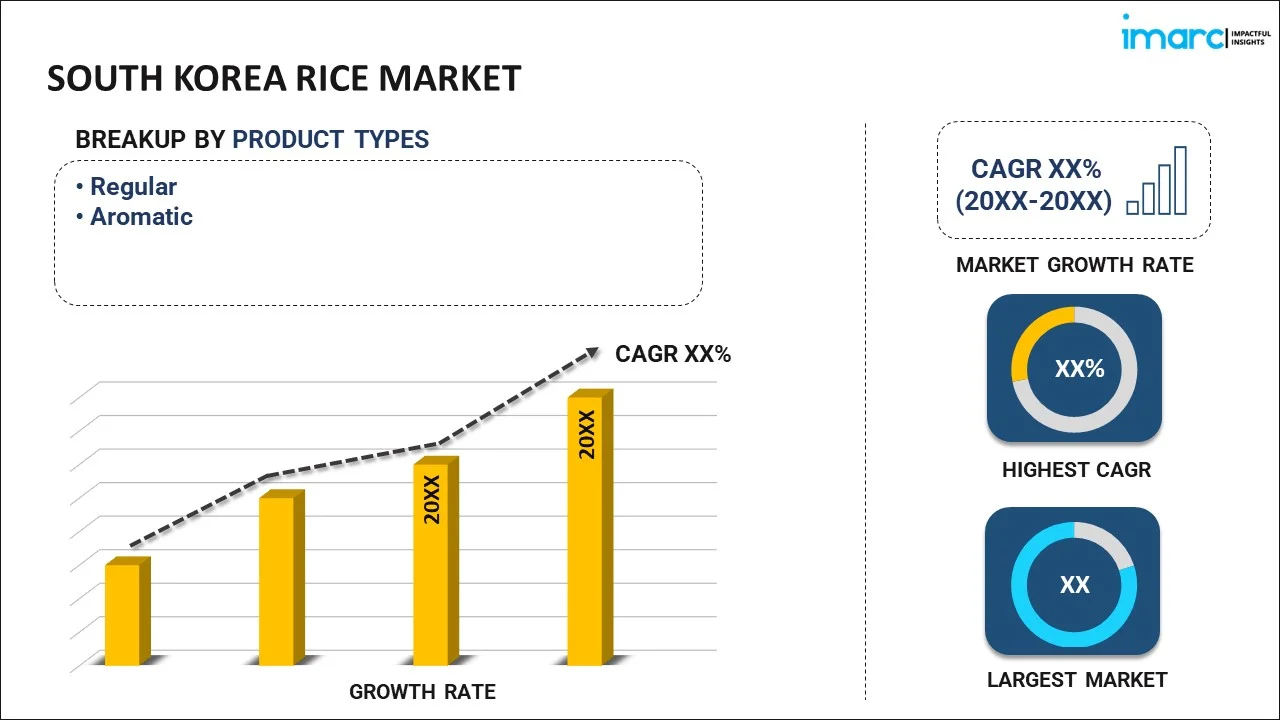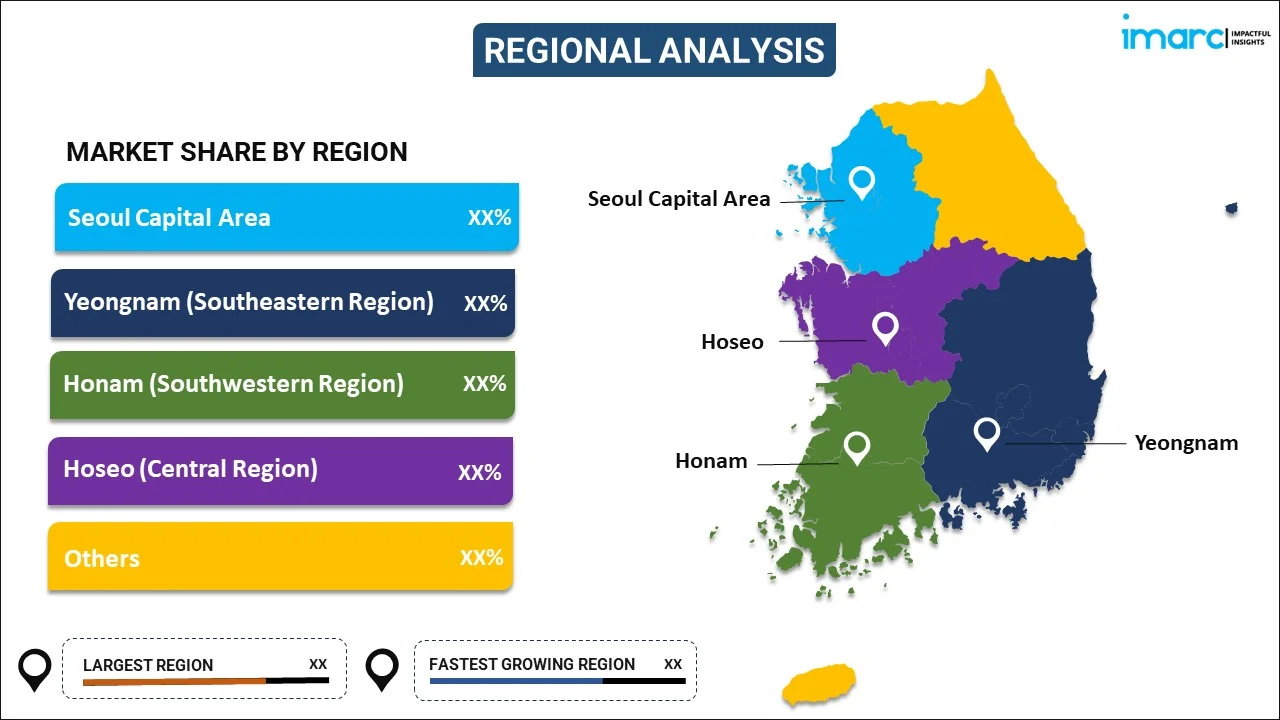
South Korea Rice Market Report by Product Type (Regular, Aromatic), Type (Red Rice, Arborio Rice, Black Rice, Grain Fragrance Rice, Brown Rice, Rosematta Rice, Grain Parboiled Rice, Sushi Rice, and Others), Grain Size (Long Grain, Medium Grain, Short Grain), Distribution Channel (Offline Stores, Online Stores), Application (Food, Feed, and Others), and Region 2024-2032
Market Overview:
South Korea rice market size is projected to exhibit a growth rate (CAGR) of 5.60% during 2024-2032. The increasing innovations in agricultural practices and technology that can lead to increased productivity and affect overall rice supply, are the market.
|
Report Attribute
|
Key Statistics
|
|---|---|
|
Base Year
|
2023 |
|
Forecast Years
|
2024-2032
|
|
Historical Years
|
2018-2023
|
| Market Growth Rate (2024-2032) | 5.60% |
Rice, a staple food, holds a profound significance in various cuisines and agricultural landscapes. Its cultivation spans diverse climates, from flooded paddies to arid fields, showcasing its adaptability. With numerous varieties such as long-grain, short-grain, and basmati, rice offers a spectrum of textures and flavors to cater to various culinary preferences. Beyond its culinary role, rice plays a crucial economic and social role in many societies, serving as a livelihood for millions of farmers. As a complex carbohydrate, rice provides a substantial source of energy and essential nutrients. Whether steamed, fried, or transformed into comforting dishes like risotto or biryani, rice is a canvas for countless culinary creations.
South Korea Rice Market Trends:
The regional rice market is influenced by various drivers, and these factors play a pivotal role in shaping the dynamics of the industry. Firstly, the ever-growing population in South Korea serves as a fundamental driver, propelling the demand for rice as a staple food. Moreover, economic factors significantly contribute to the rice market dynamics. Income levels and economic development directly impact consumer spending on food products, including rice. Rising disposable incomes often lead to increased consumption of premium rice varieties, affecting both supply and demand. Climate conditions and environmental factors also play a crucial role in determining the rice market's trajectory. Changes in weather patterns, natural disasters, and the overall climate affect crop yields, subsequently impacting prices and supply chain stability. Additionally, technological advancements in agriculture, such as improved irrigation techniques and genetically modified rice varieties, contribute to increased productivity, influencing market trends. In conclusion, a complex interplay of demographic, economic, environmental, and technological factors shapes the rice market in South Korea, making it imperative for stakeholders to navigate this multifaceted landscape effectively.
South Korea Rice Market Segmentation:
IMARC Group provides an analysis of the key trends in each segment of the market, along with forecasts at the regional and country levels for 2024-2032. Our report has categorized the market based on product type, type, grain size, distribution channel, and application.
Product Type Insights:

- Regular
- Aromatic
The report has provided a detailed breakup and analysis of the market based on the product type. This includes regular and aromatic.
Type Insights:
- Red Rice
- Arborio Rice
- Black Rice
- Grain Fragrance Rice
- Brown Rice
- Rosematta Rice
- Grain Parboiled Rice
- Sushi Rice
- Others
A detailed breakup and analysis of the market based on the type have also been provided in the report. This includes red rice, arborio rice, black rice, grain fragrance rice, brown rice, rosematta rice, grain parboiled rice, sushi rice, and others.
Grain Size Insights:
- Long Grain
- Medium Grain
- Short Grain
The report has provided a detailed breakup and analysis of the market based on the grain size. This includes long grain, medium grain, and short grain.
Distribution Channel Insights:
- Offline Stores
- Online Stores
A detailed breakup and analysis of the market based on the distribution channel have also been provided in the report. This includes offline stores and online stores.
Application Insights:
- Food
- Feed
- Others
The report has provided a detailed breakup and analysis of the market based on the application. This includes food, feed, and others.
Regional Insights:

- Seoul Capital Area
- Yeongnam (Southeastern Region)
- Honam (Southwestern Region)
- Hoseo (Central Region)
- Others
The report has also provided a comprehensive analysis of all the major regional markets, which include Seoul Capital Area, Yeongnam (Southeastern Region), Honam (Southwestern Region), Hoseo (Central Region) and Others.
Competitive Landscape:
The market research report has also provided a comprehensive analysis of the competitive landscape in the market. Competitive analysis such as market structure, key player positioning, top winning strategies, competitive dashboard, and company evaluation quadrant has been covered in the report. Also, detailed profiles of all major companies have been provided.
South Korea Rice Market Report Coverage:
| Report Features | Details |
|---|---|
| Base Year of the Analysis | 2023 |
| Historical Period | 2018-2023 |
| Forecast Period | 2024-2032 |
| Units | US$ Million |
| Scope of the Report | Exploration of Historical and Forecast Trends, Industry Catalysts and Challenges, Segment-Wise Historical and Predictive Market Assessment:
|
| Product Types Covered | Regular, Aromatic |
| Types Covered | Red Rice, Arborio Rice, Black Rice, Grain Fragrance Rice, Brown Rice, Rosematta Rice, Grain Parboiled Rice, Sushi Rice, Others |
| Grain Sizes Covered | Long Grain, Medium Grain, Short Grain |
| Distribution Channels Covered | Offline Stores, Online Stores |
| Applications Covered | Food, Feed, Others |
| Regions Covered | Seoul Capital Area, Yeongnam (Southeastern Region), Honam (Southwestern Region), Hoseo (Central Region), Others |
| Customization Scope | 10% Free Customization |
| Report Price and Purchase Option | Single User License: US$ 3699 Five User License: US$ 4699 Corporate License: US$ 5699 |
| Post-Sale Analyst Support | 10-12 Weeks |
| Delivery Format | PDF and Excel through Email (We can also provide the editable version of the report in PPT/Word format on special request) |
Key Questions Answered in This Report:
- How has the South Korea rice market performed so far and how will it perform in the coming years?
- What has been the impact of COVID-19 on the South Korea rice market?
- What is the breakup of the South Korea rice market on the basis of product type?
- What is the breakup of the South Korea rice market on the basis of type?
- What is the breakup of the South Korea rice market on the basis of grain size?
- What is the breakup of the South Korea rice market on the basis of distribution channel?
- What is the breakup of the South Korea rice market on the basis of application?
- What are the various stages in the value chain of the South Korea rice market?
- What are the key driving factors and challenges in the South Korea rice?
- What is the structure of the South Korea rice market and who are the key players?
- What is the degree of competition in the South Korea rice market?
Key Benefits for Stakeholders:
- IMARC’s industry report offers a comprehensive quantitative analysis of various market segments, historical and current market trends, market forecasts, and dynamics of the South Korea rice market from 2018-2032.
- The research report provides the latest information on the market drivers, challenges, and opportunities in the South Korea rice market.
- Porter's five forces analysis assist stakeholders in assessing the impact of new entrants, competitive rivalry, supplier power, buyer power, and the threat of substitution. It helps stakeholders to analyze the level of competition within the South Korea rice industry and its attractiveness.
- Competitive landscape allows stakeholders to understand their competitive environment and provides an insight into the current positions of key players in the market.
Need more help?
- Speak to our experienced analysts for insights on the current market scenarios.
- Include additional segments and countries to customize the report as per your requirement.
- Gain an unparalleled competitive advantage in your domain by understanding how to utilize the report and positively impacting your operations and revenue.
- For further assistance, please connect with our analysts.
 Inquire Before Buying
Inquire Before Buying
 Speak to an Analyst
Speak to an Analyst
 Request Brochure
Request Brochure
 Request Customization
Request Customization




.webp)




.webp)












